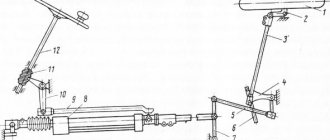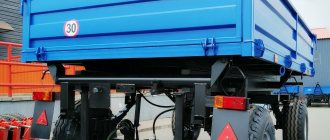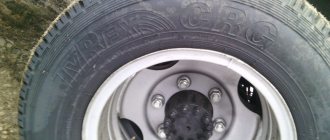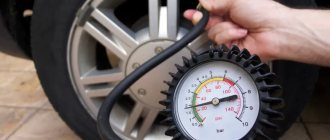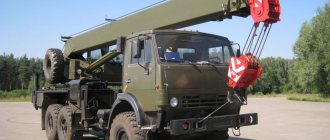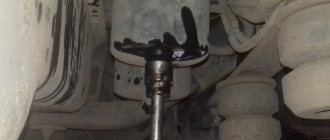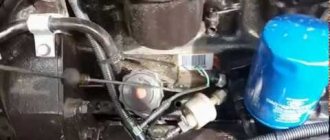The service life of the engine depends on timely and thorough lubrication, as well as on the type and quality of oils and lubricants used.
To prevent dirt from penetrating into the mechanisms, thoroughly clean the lubrication points and wash the oil nipples.
Checking the oil level and topping up
Clean the filler neck from dust and dirt. Take out the oil measuring rod 2 (Fig. 1), wipe it with a rag and insert it into the tube until it stops.
Then remove the rod again and determine the oil level: it should be between the “B” and “H” marks, closer to the “B” mark.
If the engine was running, check the oil level should be carried out 3... 5 minutes after stopping it.
If the level is close to the “H” mark, add fresh oil to filler neck 1, located in the front part of the engine, behind the fan drive fluid coupling to the required level.
When checking the oil level, pay attention to its quality.
If marks are visible on the measuring rod through the oil film, the oil is suitable for further use.
If the risks are difficult to distinguish due to the dark color of the oil, it must be replaced.
The degree of oil contamination can also be assessed by the color of the oil stain on white filter paper.
If only the middle of the spot is black, the oil filter filter elements should be replaced and the centrifugal filter rotor cap should be washed, and if the entire spot is black, the oil should be changed.
How much oil is in a YaMZ engine
Over the course of its existence, the YaMZ-238 engine has undergone many modifications, but the basic design has remained virtually unchanged.
This power unit is considered one of the most reliable and powerful for trucks and agricultural machinery. The volume of oil in the engine is the most important characteristic, failure to comply with which will prevent normal operation of the unit. This indicator is closely related to data such as the number of working hours before replacement and the class of lubricants recommended in the instructions.
History and characteristics of YaMZ 238
The Yaroslavl Motor Plant produces a whole line of engines, the prototype of which can be considered the YaMZ 238. Production of this engine began in 1962. It became an improved version of the previously assembled YaMZ 236 (six-cylinder), but for many years both power units continued to be actively used in parallel with each other. The family has many common features: design features, operating principles, similar technical indicators. Later, the YaMZ 530 appeared - four- and six-cylinder in-line engines, both diesel and gas.
The engines of the Yaroslavl plant serve on powerful MAZ, Urals, KrAZ trucks, tractors and combines, river and sea boats, as well as diesel power plants. Due to its reliability and unpretentiousness, the engine still remains in demand, and its production continues. The newest version of YaMZ-238/Euro-0 Turbo is distinguished by the presence of a turbine. In addition to other design improvements, it is equipped with a liquid-oil heat exchanger and a high-pressure fuel pump.
By design, the YaMZ-238 power unit is an eight-cylinder V-shaped double-row body made of low-alloy gray cast iron, the camber angle of this engine is 90°.
Main design features and technical characteristics:
- offset of the cylinder rows relative to each other by 35 mm;
- working volume 14.85 l;
- naturally aspirated;
- power from 180 to 240 hp;
- fuel consumption (100% power) – 227 g/kW hour.
Oils for YaMZ
The strength of the YaMZ 238 engine is a carefully thought-out and trouble-free oil lubrication system for all components. A mixed scheme is used here, its operating principle is that the main and connecting rod bearings located in the key components of the unit - the camshaft and crankshaft - are lubricated under pressure. Also serviced are the connecting rod upper head bushings, oil pump idler gear, valve rocker arm bushings, pushrod bushings and spherical rod bearings. The remaining elements - the cylinder bore, rolling bearings, gears and camshaft cams - do not require as much lubrication and are maintained by spraying. A system of oil channels is provided on the walls of the cylinder block to supply lubricant to the components and filters of the mechanism.
According to the instructions, GOST 5304-54 diesel oil is used to service 238 series engines. Also in the accompanying documents you can find recommendations for the use of motor oil additives that improve the functioning of the oil filled into the engine.
Main elements of the YaMZ 238 lubrication system:
- standard gear type oil pump;
- centrifugal fine oil filter with jet drive;
- Full-flow oil filter based on a metal mesh with a replaceable filter element.
Characteristics of YaMZ 238 filling containers
The YaMZ 238 engine uses a mixed-type lubrication system with a “wet” sump.
You can find out how much oil will need to be poured into the YaMZ 238 engine based on the size of the unit’s filling tanks. In particular, the lubrication system has a volume of 32 liters of oil.
The engine cooling system without a radiator requires 20 liters of lubricants. The fuel pump needs 0.2 liters, the air filter capacity is 1.4 liters. The 238 model, unlike the 236, does not have a regulator.
The oil volume in the YaMZ 238 engine is measured using a special dipstick with o and “minimum”. 24-28 liters are poured at a time, despite the fact that the working volume of the lubrication system of this power unit reaches 32 liters. if during operation the oil pressure in the system is increased to more than 520 kPa (5.2 kgf/sq.cm), excess lubricants are returned through the oil line and simultaneously cleaned by filters.
Maintenance and repair of YaMZ 238
It is recommended to carry out service maintenance of the YaMZ 238 engine after 20,000 - 25,000 km. When checking, the oil pressure should give readings of 4-7 kgf/cm2 on a warm engine. The indicator is the same for atmospheric and turbo systems. Changing lubricants is necessary during scheduled maintenance, as well as when drips, smoke, or knocking appear when the engine is running, while the capacity of different systems varies, as does the replacement time.
You can familiarize yourself with the technology for servicing power units in the repair and operation manual developed by the manufacturer. The set of mandatory operations when carrying out maintenance of an internal combustion engine at the Yaroslavl plant includes the following manipulations:
- Change of oil;
- checking and replacing filters: fine filter,
- coarse filter,
- fuel purification filters,
- eco-filter exhaust system,
- air filter;
Important : the YaMZ 238 engine urgently needs repairs if blue smoke appears during operation. This indicates that the lubricant is burning.
content .. 1011 12 ..
Lubrication system of the YaMZ-238NB engine of the K-700 “Kirovets” tractor
The engine lubrication system is combined (Fig. 5). The crankshaft main and connecting rod bearings, camshaft bearings, connecting rod upper end bushings, valve rocker arm bushings, oil pump drive intermediate gear bearing, turbocharger bearings, rod supports and pusher bushings are lubricated under pressure; the remaining nodes are sprayed. The direction of oil movement in the system is shown in Figure 5. The pressure in the central oil channel 12 at nominal speeds is 4-7 kg/cm2, at minimum idle speed - at least 1 kg/cm2; the pressure in the bearing housing 10 of the turbocharger at rated speed is not less than 3 kg/cm2, at minimum idle speed is not less than 0.5 kg/cm2.
Rice. 5. Lubrication system diagram:
The oil pump is gear type, installed on the front main bearing cover and driven by the crankshaft gear through the intermediate gear 5. The pump consists of two sections - main 4 and radiator 3, which supply oil to the lubrication system and the oil cooler, respectively. Reducing valve 2 of the main section is adjusted to a pressure of 7.0 ~ 7.5 kg/cm2, and safety valve 1 of the radiator section is adjusted to a pressure of 0.8-1.2 kg/cm2. At higher pressures at the pump outlet, both valves bypass oil back into the sump. The performance of the main pump at an oil temperature of 85--95°C and rated engine speed is at least 140 l/min.
Oil pan 14 is attached to the cylinder block with bolts. The connector area is sealed with a cork gasket. Oil is poured into the engine sump through a filler neck located on one of the cylinder head covers. The system capacity (without radiator) is 32 liters, the oil level in the system is controlled by a dipstick located in the front of the engine. Oil drains
through two plugs located at the bottom of the pan.
Pre-oil filter 7 is installed at the front end of the engine. A bypass valve 6 is installed in the filter housing, adjusted to a pressure drop of 2.0–2.5 kg/cm2. When the pressure difference before and after the filter exceeds this value, part of the oil, bypassing the filter, enters directly into the oil line. The filter consists of a housing, a removable cap, and two sections of filter elements operating in parallel - internal and external. Brass mesh is used as filter elements, the square cells of which have
size 0.125×0.125 mm.
Every 120 operating hours of the engine, it is necessary to wash the coarse oil filter. To wash, unscrew the drain plug, drain the oil from the filter, remove the housing cap and remove the outer and inner sections of the filter elements. The filter elements are placed for at least 3 hours in a bath with a solvent - gasoline or carbon tetrachloride, then cleaned with a hair brush, rinsed in a solvent and blown with compressed water.
air. The filter cap is washed in diesel fuel and assembled.
Fine oil filter 8 - centrifugal type - is installed at the front end of the engine. The filter is connected in parallel to the system and passes up to 10% of the oil, which is drained into the pan. At an oil pressure of 4-6 kg/cm2 and a temperature of 85-90 ° C, the rotation speed of the centrifuge rotor is 4500-5000 rpm. The filter consists of a housing, a removable cap, an axis and a rotor. The oil enters the lower part of the rotor, comes out from under the reflector, rises to the upper part of the rotor and then flows through intake tubes and two nozzles directed in different directions, creating a couple of forces, into the internal cavity of the filter housing.
The hydraulic torque of the oil jets coming out of the nozzles at high speed causes the rotor to rotate. Under the influence of centrifugal forces, mechanical impurities of the oil in the rotor are deposited on its inner walls.
The centrifugal oil filter must be washed every 60 engine hours. To wash, remove the filter cap; Having removed the pin and thrust washer, remove the rotor assembly; disassemble the rotor; remove sediment from the cap and rotor; wash the cap, rotor and mesh with diesel fuel and assemble the filter in reverse order.
The oil supplied to lubricate the bearings 10 of the turbocharger is cleaned in filter 9, which is similar in design to a fine fuel filter.
A drain valve 13 is installed in the lubrication system, which serves to stabilize the pressure. The valve is adjusted to start opening at a pressure in the central oil channel equal to 4.7-f-5.0 kg/cm2.
Oil cooler 1 (Fig. 6) is installed in the front part of the tractor in front of the gearbox oil cooler. The radiator is steel, single-row, tubular-fin type.
content .. 10
11 12 ..
How much oil is in the Yamz 238 injection pump?
The fuel equipment of the YaMZ-238 engine has a common lubrication system with the engine. The total volume of the lubrication system of this engine is 32 liters, while oil is usually filled with 24-28 liters.
How to bleed a Yamz 238 fuel pump?
How to remove air from a Yamz 238 injection pump
de2?
From the fuel system? If it does not leak anywhere (most often this problem is in the fuel booster pump), then to remove air from the fuel system, you need to unscrew the handle of the manual booster pump and pump
the system for 2-3 minutes.
- How much does a Yamz 238 engine weigh?
- Yamz 238 how much horsepower
- How much does a Yamz 236 engine weigh?
- Where is the engine number Yamz 236
- How to set the ignition on Yamz 238
- Where is the engine number Yamz 238
- How to add fuel to Yamz 238
- How to adjust valves Yamz 238
- How much oil is in a box of maz
What pressure should be in the Yamz 238 injectors?
On the injectors
YaMZ 238
engines use shims.
The higher the overall thickness, the greater the pressure
.
Maintenance of nozzles
involves checking the tightness of the nozzle.
For adjustment, a pressure
of about 1.5 MPa is created.
How many liters of oil are in a Kraz engine?
Characteristics of YaMZ 238 filling containers
In particular, the lubrication system has a volume of 32 liters of oil
. The engine cooling system without a radiator requires 20 liters of lubricants. The fuel pump needs 0.2 liters, the air filter capacity is 1.4 liters.
What kind of oil to pour into the 7511 engine?
According to GOST 17479.1-85 on YaMZ
winter, summer and all-season
oils
oil
viscosity classes 8, 10 and 5z/10, 5z/14, 6z/14.
Winter oil
corresponding to viscosity class 8 is used in the ambient temperature range from -15 to +10°C.
How to remove air from the fine fuel filter?
Open the fine filter purge
and pump the fuel with a manual pump until a continuous stream without air bubbles comes out of the drain tube.
Close the valve. Unscrew the bleeder plug in the fuel pump head 2-3 turns and remove
air
from it .
Diesel engines of trucks and tractors. Spare parts, adjustments and repairs.
________________________________________________________________
________________________________________________________________
Cooling system and lubrication system of the YaMZ-238 engine
Cooling system for the diesel engine YaMZ-238 The cooling system for the YaMZ-238 diesel engine for Maz, Kraz, Ural cars, and the K-700 tractor (Fig. 17) is liquid, circulation, including a water pump, liquid-oil heat exchanger, fan, thermostats.
Rice. 17. Diagram of the cooling system of the YaMZ-238 diesel engine 1 – water pump; 2 – cavity of the liner cooling block; 3 – water cavity in the block head; 4 – longitudinal water channel; 5 – turbocharger; 6 – right water pipe; 7 – connecting pipe; 8 – inlet pipe; 9 – thermostat; 10 – tee with connecting tubes; 11 – bypass tube; 12 – plug; 13 – inlet pipe of the liquid-oil heat exchanger; 14 – fan; 15 – transverse water channel; A – coolant supply from the water radiator; B – to the cabin heater; B – air release; G – supply of charge air to the air-to-air cooler; D, F – to the radiator; E - from the air-to-air charge air cooler to the cylinders. In addition, the cooling system of the YaMZ-238 diesel engine includes a water radiator, an air-to-air charge air cooler and a remote thermometer installed on the vehicle. During operation of the YaMZ-238 diesel engine, the circulation of coolant in the cooling system is created by a centrifugal pump. From the water pump of the YaMZ-238 engine of Maz, Kraz, Ural cars, and the K-700 tractor (1), the liquid enters the transverse channel 15 and then through the right longitudinal channel 4 into the water cavity of the right bank of cylinders, and into the left bank of cylinders through the inlet pipe liquid-oil heat exchanger 13, cooling the oil in two elements, then into the left longitudinal channel. In order for the coolant to pass through the liquid-oil heat exchanger, a plug 12 is pressed into the front cover of the distribution gears. Next, the coolant from the water cavities of the cylinders through the guide channels enters the cylinder heads to the most heated surfaces - the exhaust channels and injector cups and is then collected in the drainage basins. pipes 6. When a cold YaMZ-238 engine is heated, the channels connecting the drainage pipes to the radiator are closed by thermostat valves 9. The coolant circulates through the tee with connecting pipes 10 and the bypass pipe 11 to the water pump, bypassing the radiator, which speeds up engine warming up. When the water cooling system of the YaMZ-238 engine reaches a temperature of 80°C, the thermostat valves open, the heated liquid enters the water radiator, where it gives off heat to the air flow created by fan 14, after which it again goes to the water pump. When coolant temperature drops, thermostats automatically direct all coolant flow directly to the water pump, bypassing the radiator. Thus, through thermostats, the optimal thermal operating conditions of the YaMZ-238 engine are ensured. Water pump of the YaMZ-238 diesel engine The water pump (pump) of the YaMZ-238 internal combustion engine is of centrifugal type, installed on the front wall of the cylinder block and driven by a V-belt from a pulley mounted on the front end of the crankshaft. The design of the YaMZ-238 diesel pump for Maz, Kraz, Ural cars, and the K-700 tractor is shown in Figure 18.
Rice. 18. Water pump (pump) of diesel engine YaMZ-238 1 – drive pulley; 2 – retaining ring; 3 – bearings; 4 – roller; 5 – water release; 6 – end seal; 7 – pump housing; 8 – sealing ring; 9 – water pump pipe; 10 – impeller; 11 – impeller plug; 12 – sealing ring; 13 – sealing ring bushing; A – mechanical seal; B – drainage hole In the cast iron pump casing 7, an impeller 10 pressed onto roller 4 rotates, creating a flow of coolant. The YaMZ-238 water pump roller is mounted on two ball bearings 3 with a one-sided seal. When assembling the pump, the bearing cavity is filled with Litol lubricant for the entire service life of the pump without additional lubrication. The bearing cavity of the YaMZ-238 internal combustion engine pump is sealed with a self-clamping end seal. To monitor the tightness of the mechanical seal, there is a drainage hole “B” in the pump housing. Drive pulley 1 is pressed onto the pump shaft. The water pump of the YaMZ-238 diesel engine is marked on the housing 236-1307010-B1. Diesel engines YaMZ-238 of Maz, Kraz, Ural cars, K700 tractors are equipped with a friction fan drive designed to turn the fan on and off depending on operating conditions. The use of friction drive of the YaMZ-238 diesel engine makes it possible to: Ensure optimal thermal conditions of the engine. Reduce fuel consumption by reducing power losses due to fan operation. Increase the reliability of the gear drive of the engine by reducing dynamic loads on the gears. Reduce engine warm-up time. Improve comfort by maintaining an appropriate cabin climate and reducing noise. Lubrication system for the YaMZ-238 diesel engine The lubrication system for the YaMZ-238 diesel engine of Maz, Kraz, Ural cars, and the K-700 tractor is mixed, with a “wet” sump (Fig. 19).
Rice. 19. Diagram of the lubrication system of the YaMZ-238 diesel engine with a single-section oil pump and liquid-oil heat exchanger 1 – oil sump; 2 – oil intake; 3 – oil pump; 4 – pressure reducing valve; 5 – liquid-oil heat exchanger; 6 – oil filter; 7 – bypass valve; 8 – filter signal lamp; 9 – centrifugal oil purification filter; 10 – camshaft; 11 – pusher axis; 12 – crankshaft; 13 – differential valve; 14 – piston cooling nozzle; 15 – valve of the piston cooling system; 16 – turbocharger; 17 – heat exchanger bypass valve; 18 – fan drive switch; 19 – fan drive; 20 – Injection pump Oil pump 238B-1011014-A with a capacity of 140 l/min (Fig. 20) sucks oil from the crankcase through a suction pipe with an intake and supplies it to the system through a series-connected liquid-oil heat exchanger. Rice. 20. Oil pump for internal combustion engine YaMZ-238 1 – intermediate gear; 2 – axis of the intermediate gear; 3 – drive shaft; 4 – housing cover; 5 – driven shaft-gear; 6 – body; 7 – drive gear; 8 – key; 9 – thrust flange A bypass valve is installed in the heat exchanger body (plate). When the pressure difference before and after the heat exchanger reaches 274±40 kPa (2.8±0.40 kgf/cm2), the valve opens and part of the oil is supplied directly to the oil line. From the liquid-oil heat exchanger, oil enters the channels of the block through a differential valve designed to maintain constant pressure in the system. When the pressure rises above 520 kPa (5.2 kgf/cm2), part of the oil is drained into the crankcase. Next, through the channels in the block, part of the oil through the valve of the YaMZ-238 diesel piston cooling system flows to the piston cooling nozzles and then drains into the crankcase. The valve of the piston cooling system of MAZ, Kraz, Ural cars, and the K-700 tractor stops supplying oil to the injectors when the oil pressure in the lubrication system is below 130 - 165 kPa (1.30 - 1.65 kgf/cm2). The other part goes into the oil filter (Fig. 21). Rice. 21. Diesel oil filter YaMZ-238 1 – filter housing; 2 – cap gasket; 3 – lock cover; 4 – filter cap; 5 – filter element; 6 – cap head; 7 – filter element gasket; 8 – valve plunger; 9 – valve spring; 10 – alarm spring; 11 – moving contact of the signaling device; 12 – fixed contact; 13 – terminal A bypass valve is installed in the filter housing. When the pressure difference before and after the filter reaches 200 - 250 kPa (2.0 - 2.5 kgf/cm2), the valve opens and part of the crude oil is supplied directly to the oil line. By the time the bypass valve begins to open, the moving and fixed contacts of the alarm will close. At this moment, a warning light connected to the signaling device terminal lights up in the driver’s cabin. Such an increase in pressure can occur when the filter element is clogged or the oil has a high viscosity (for example, when starting the engine in the cold season). The filter element of the YaMZ-238 oil filter is made either of non-woven material stretched over a metal frame, or of special filter paper. From the filter, oil flows into the central oil channel, and from there, through a system of channels in the block, to the bearings of the crankshaft and camshaft. From the crankshaft bearings YaMZ-238 of Maz, Kraz, Ural cars, and the K-700 tractor, oil is supplied through oil channels in the crankshaft and connecting rods to the bearings of the upper heads of the connecting rods. From the camshaft of the YaMZ-238 diesel engine, oil is directed in a pulsating flow to the axis of the pushers, and from there, through the channels of the pushers, cavities of the rods and rocker arms, it flows to all the rubbing pairs of the valve drive, and through the outer pipe to the bearings of the turbocharger, speed controller and high-pressure fuel pump . The bearing of the intermediate gear of the YaMZ-238 oil pump drive is also lubricated under pressure. Unit drive gears, camshaft cams, rolling bearings, and cylinder liners are splash lubricated. A pressure reducing valve is installed on the front flange of the outlet pipe of the YaMZ-238 oil pump, which transfers oil back into the crankcase at a pressure at the pump outlet above 700 - 800 kPa (7.0 - 8.0 kgf/cm2). To stabilize the pressure, a differential valve is included in the lubrication system of the YaMZ-238 engine, adjusted to start opening at 490 - 520 kPa (4.9 - 5.2 kgf/cm2). Oil pressure is monitored in the central oil channel. Rice. 22. Centrifugal oil purification filter YaMZ-238 1 – filter cap; 2, 7 – washers; 3 – cap nut; 4 – rotor fastening nut; 5 – thrust washer; 6 – rotor nut; 8, 14 – rotor bushings; 9 – rotor cap; 10 – rotor; 11 – reflector; 12 – sealing ring; 13 – cap gasket; 15 – rotor axis; 16 – filter housing; 17 – rotor nozzle; A – from the system under pressure; B – draining oil into the crankcase The YaMZ-238 centrifugal oil purification filter (Fig. 22), included in the lubrication system in parallel after the oil filter, allows up to 8% of the oil passing through the lubrication system. The YaMZ-238 filter for Maz, Kraz, Ural cars and the K700 tractor is designed for fine filtration of oil. The oil is cleaned under the action of centrifugal forces when the rotor rotates. Jets of oil coming out of the nozzle at high speed create a torque that causes the rotor to rotate. Mechanical impurities in the oil are thrown “to the wall” of the rotor cap 9 under the influence of centrifugal forces, forming a dense layer of deposits on its internal surfaces, which should be periodically removed. The purified oil is drained into the crankcase. Additional centrifugal oil purification is also carried out in the cavities of the connecting rod journals of the YaMZ-238 crankshaft. Turbocharger of the YaMZ-238 diesel engine The YaMZ-238 diesel engine of Maz, Kraz, Ural cars, and K700 tractors is equipped with a turbocharger that uses the energy of exhaust gases to supercharge the engine. By increasing the mass of air entering the cylinders, the YaMZ-238 turbocharger promotes more efficient combustion of the increased dose of fuel. This increases engine power at moderate thermal stress. The design of the YaMZ-238 diesel engine turbocharger The YaMZ-238 diesel engine turbocharger (Fig. 23) consists of a single-stage centrifugal compressor and a radial centripetal turbine.
Rice. 23. Turbocharger YaMZ-238 1 – compressor wheel fastening nut; 2 – thrust bearing; 3 – bolt; 4 – compressor housing; 5 – insert; 6 – compressor housing cover; 7 – sealing ring; 8 – compressor plate; 9 – bolt; 10 – bolt-stopper; 11 – turbine plate; 12 – bearing housing; 13 – turbine housing spacer; 14 – turbine wheel with shaft; 15 – turbine housing; 16 – sealing rings; 17 – bushing; 18 – bolt; 19 – oil discharge screen; 20 – thrust washers; 21 – sealing ring; 22 – screw; 23 – compressor wheel The turbine wheel 14 and the compressor wheel 23 are located at opposite ends of the rotor shaft in cantilever relative to the bearing sleeve 17. The impeller 23 of the centrifugal compressor is a semi-open type, with blades curved against rotation, cast from an aluminum alloy. It is pressed onto the shaft and secured with nut 1 installed with sealant. Turbine impeller 14 is a semi-open type, with radial blades, made by casting from a heat-resistant alloy. It is connected to the shaft using friction welding. The YaMZ-238 turbine housing is made of heat-resistant cast iron. Gas is supplied to the turbine wheel through two tapering channels. At the end of the turbine housing there are studs for fastening the exhaust pipeline. The compressor housing 4, insert and bearing housing cover 6 are made of aluminum alloy. The bearing housing cover 6 is attached to the bearing housing with bolts 3 using sealant. The turbocharger of the YaMZ-238 diesel engine uses a plain bearing 17 in the form of a sleeve made of aluminum alloy. It is installed in the bore of the cast iron bearing housing 12 and is held against axial movements by a stopper bolt 10. The YaMZ-238 turbocharger bushing is lubricated under pressure from the engine lubrication system. A carefully balanced rotor is installed in a sleeve 17. The axial forces acting on the rotor are absorbed by a thrust bearing 2. At each end of the rotor shaft, split sealing rings 16, made of special cast iron, are installed. The YaMZ-238 diesel turbocharger is attached to the exhaust manifolds by the turbine housing. The outlet pipe of the compressor housing is connected through pipes and the charge air cooler to the engine intake manifolds.
___________________________________________________________________
___________________________________________________________________
- Injection pump D-245 - design and adjustments
- Timing belt and valves D-245
- Engine lubrication system D-245
- Fuel system parts D-245
- Operations for adjusting YaMZ-236
- Operations for disassembling and installing fuel injection pump YaMZ-236
- Cooling system and lubrication system YaMZ-238
- Fuel injection pump YaMZ-238
- Characteristics of Cummins ISBe, ISLe, ISB, QSB
___________________________________________________________________
___________________________________________________________________
- Repair and replacement of Cummins ISBe, ISLe, ISB crankshaft
- Cummins ISBe, ISLe, QSB cylinder block repair
- Connecting rod and piston group Cummins ISBe, ISLe, ISB
- Diesel cooling system ISF 2.8
- ISF 2.8 diesel cylinder block and pistons
- Cummins ISF 3.8 Fuel System Components
- Cummins 3.8 engine lubrication system
- Cummins ISF 3.8 Cooling System
- Cylinder head YaMZ-7511
- YaMZ-7511 cylinder block
- Diesel crankshaft YaMZ-7511
Engine YaMZ-238
The YaMZ-238 diesel engine produced by the Yaroslavl Motor Plant is designed for heavy-duty MAZ vehicles and special equipment and has good fuel-economic, efficient and operational characteristics. The environmental standard of the motor complies with EURO-2.
YaMZ diesel modifications: B, DE, ND, AK, M2, DE2, D, etc.
The appearance of a diesel engine with individual cylinder heads and a plate-type liquid-oil radiator (LOR) is shown in Figure 1.
Figure 1 – Diesel with individual cylinder heads
Technical characteristics of the YaMZ-238 diesel engine
Engine type - Four-stroke with compression ignition and turbocharging Number of cylinders - 8 Cylinder arrangement V-shaped, camber angle - 90 degrees Cylinder operating order - 1-5-4-2-6-3-7-8 Direction of crankshaft rotation - Right Cylinder diameter, mm — 130 Piston stroke, mm — 140 Displacement, l — 14.86 Compression ratio — 16.5 Rated power, kW (hp) — 294 (400) Crankshaft speed at rated power, min -1 — 1900 Maximum torque, Nm (kgcm) — 1715 (175) Rotation speed at maximum torque, min-1 — 1100-1300
Idle speed, min-1:
— maximum — 2150 — minimum — 600±50
Specific fuel consumption according to speed characteristics, g/kW h (g/hp.h):
— minimum — 194 (143) — at rated power — 215 (158)
Specific oil consumption for waste in % of fuel consumption, no more than - 0.2 Method of mixture formation - Direct injection Combustion chamber - Undivided type in the piston Camshaft - Common for both rows of cylinders, with gear drive
— intake valves — opening, deg. to TDC - 21.5 / closing, deg. after BDC - 31.5 - exhaust valves - opening, deg. to TDC - 63 / closing, deg. after BDC - 29.5
Number of valves per cylinder - One intake and one exhaust Thermal valve clearances on a cold engine, mm - 0.25-0.30
Diesel lubrication system YaMZ-238 DE, B, ND
Type - Mixed, with oil cooling in a liquid-oil heat exchanger (LOH): the bearings of the crankshaft, camshaft, rocker arm axles, high-pressure fuel pump, turbocharger are lubricated under pressure; the remaining rubbing surfaces are lubricated by splashing.
Oil pump - Gear type, single section
Oil pressure in a warm engine in the block line kPa (kgf/cm2):
- at rated speed - 400-700 (4-7) - at minimum speed, not less - 100 (1)
Oil filters - Two: full-flow fine oil filter (PFTOM) with a replaceable filter element and a centrifugal oil purifier (CM)
Oil cooling system - With a liquid-oil heat exchanger (LOH), which is installed on the engine, plate or tubular type
Piston oil cooling system - Jet oil cooling nozzles for pistons with holes 2.5 mm in diameter are located on pipes on the right and left sides of the engine with oil sampling through a throttle bushing with a diameter of 6 mm in the section of the engine lubrication system between the liquid coolant and the PFT.
Oil pressure at the beginning of opening of the lubrication system valves, kPa (kgf/cm2):
- oil pump pressure reducing valve - 700-800 (7.0-8.0) - differential valve - 490-520 (4.9-5.2) - oil filter bypass valve - 200-250 (2.0-2. 5) - oil filter bypass valve opening indicator - 180-230 (1.8-2.3) - LMC bypass valve 274±25 (2.8±0.25) (only for plate type LMC)
Fuel system of the YaMZ-238DE2, 238ND5, 238AK engine
Type - Split type High pressure fuel pump with regulator and fuel priming pump - Eight-section, plunger type, spool type plungers. Injection pump model - 175.1111005-40 Operating order of the fuel pump sections - 1-3-6-2-4-5-7-8 Speed controller - Centrifugal, all-mode Fuel lifting pump - Piston with manual fuel pump
Injectors - Closed type, with multi-hole nozzles: on engines with common heads - 267.1112010-02 or 204.1112010-50.01 / on engines with individual heads - 51.1112010-01
Installation angle of advance of fuel injection (set by marks on the flywheel and fuel injection pump housing):
- on engines with common heads - (6+1) degrees - on engines with individual heads - (8+1) degrees
— coarse cleaning — filter-settler — fine cleaning — With a replaceable filter element. There is a bypass valve-nozzle on the cover. Opening pressure of the valve-jet 20-40 (0.2-0.4) kPa (kgf/cm2)
Pressurization system - Gas turbine with one turbocharger with a radial centripetal turbine and a centrifugal compressor Turbocharger - Model 122 (YaMZ) Boost pressure (excess) at nominal operating mode, kPa (kgf/cm2) - 125 (1.25)
Cooling system of diesel engine YaMZ-238 AK, M2, D
Type - Liquid, closed type, with forced circulation of coolant. The cooling system is equipped with a thermostatic device to automatically maintain the thermal operating conditions of the engine.
Water pump - Centrifugal type, belt driven. Fan - Six-bladed, with a gear drive and a friction fan clutch. Liquid-oil heat exchanger - Plate or tubular type. Equipped with a tap or plug for draining the coolant. Thermostats - With solid filling. The opening temperature is 80 C.
Changing the oil and flushing the lubrication system
To remove deposits from the crankcase along with the oil, drain the oil from a warm engine, observing safety precautions.
To drain the oil, unscrew the drain plug on the crankcase 3 and remove the oil filler cap, having previously cleaned it of dust and dirt.
After the oil is completely drained, tighten the plug.
Fill the engine with a flushing mixture consisting of 10 liters of diesel fuel and 6 liters of oil.
Start the engine and let it run for 5 minutes at minimum crankshaft speed.
Stop the engine and drain the flushing fluid.
Replace the two replacement filter elements and wash the oil filter and centrifugal oil filter caps in diesel fuel. Fill the engine with fresh oil.
Pour oil into the engine through the filler neck on the cylinder head cover.
Before filling, clean the neck from dust and dirt, check the tightness of the oil sump drain plug: tightening torque 140...160 Nm (14...16 kgf m).
Fill oil from oil dispensing columns using dosing guns, and if there are no columns, through a funnel with a mesh made of clean filling containers.
Close the filler cap. 32 liters of oil are poured into the system.
Changing the filter elements of a full flow oil filter
1. Unscrew the filter cap 3–4 turns and drain the oil through the housing channel into a nearby container.
To unscrew the cap, you can use a key, as shown in Fig. 2.
2. Unscrew completely and remove filter cap 5 (Fig. 2).
3. Press the lock cover 3 and, having sunk it into the cap 5 by 2 - 3 mm, turn it 45º, after which it will disengage with the cap flange.
Remove the locking cover and filter element 4 from the cap.
4. Rinse the inner cavity of the cap with diesel fuel. Cleaning is not allowed even with a clean rag.
5. Install a new filter element into the cap with the rubber gasket facing out.
Install the locking cover into the gasket hole, ensuring the correct position of the gasket.
Pressing the lock cover, push it together with the element into the cap and turn it 45º.
The protrusions of the cap flange will fit into the grooves of the cover, after which the spring will press the cover into the working position.
6. Screw the cap with the element onto the housing fitting 1 and tighten to a torque of 20...40 Nm (2...4 kgf m).
7. With the engine running, make sure there is no oil leakage through the cap seal.
After four filter element replacements, replace sealing gasket 2.
Washing the centrifugal oil filter
1. Unscrew the nut of the filter cap (Fig. 4) and remove the cap.
2. Unscrew the rotor mounting nut; remove the rotor with thrust washer 9 (Fig. 5).
3. Disassemble the rotor by unscrewing nut 8, removing washer 7 and rotor cap 6.
4. Remove deposits from the cap 6 and rotor 5 and wash them in diesel fuel.
5. Reassemble the filter in reverse order, checking the condition of gaskets 2 and 4, rotor nozzles 3 and washers 12.
If necessary, replace the gaskets and clean the rotor nozzles.
Reliability, problems and repair of YaMZ-238
The YaMZ-238 series was put into production in 1962 and replaced the YaAZ-206.
This engine has a V-shaped 8-cylinder cast iron block, with a camber angle of 90°, with cast iron wet liners and with the cylinder rows offset relative to each other by 35 mm. Inside the block, a forged crankshaft with a piston stroke of 140 mm and a main journal diameter of 110 mm and a connecting rod journal diameter of 88 mm is installed on 5 supports; the connecting rods themselves are steel, and their length is 265 mm. For these engines, cast aluminum pistons with a diameter of 130 mm and a height of 100 mm were used, with a piston pin diameter of 50 mm. In addition to atmospheric variants, turbocharged ones were also produced, the list of which knows no bounds. The main differences between them are listed below.
This motor had a related series YaMZ-236.
The production of 238 continues to this day, but they are being replaced by more environmentally friendly YaMZ-7511 and YaMZ-658.
Modifications of YaMZ 238 and their differences
1. YaMZ-238AK - an analogue of the YaMZ-238M2 under Euro-0 standards, which was intended for Don, Kuban, Khersonets, Slavutich and Palesse FS60 combines. Power 235 hp at 2000 rpm, torque 932 Nm at 1300-1500 rpm. The service life of the motor before overhaul is 8000 hours. 2. YaMZ-238AM2 - version of YaMZ-238M2 with a power of 225 hp. at 2100 rpm, torque 825 Nm at 1250-1450 rpm. The environmental class is Euro-0, and its resource is 8000 hours. It is installed on the MoAZ-6014 and 6442. 3. YaMZ-238B - a turbocharged engine based on the YaMZ 238M2, which uses a TKR 100 turbocharger. A modified camshaft with the following characteristics is installed here: phase 240/266, injectors 261-13, another crankshaft, its own pistons , pump 807-40. The motor complies with Euro-0 standard. You can meet him at VPR-02, VPRS-02 and 03; MAZ-5336 and 5432; MoAZ-40484, 40489, 49011 and 7505; KrAZ 5444, 6130, 6503 and 6505; ADM-1.5, MPG-6, EO-5225, Ural 5323 and 5423; CHETRA T20, EK400 and REM25. Engine life is 450 thousand km. 4. YaMZ-238BV - analogue of 238BL, but with fuel injection pump 807-40. Installed on GT-TM, GT-TMS and MGSh521M1. Resource - 8000 hours. 5. YaMZ-238BE - the same YaMZ-238B, but with a built-in liquid-oil heat exchanger and modified cooling and lubrication systems. It uses a YAZDA 807-50 fuel injection pump, 261-13 injectors and a TKR 122 turbine. The boost pressure is 0.93 bar. Power 300 hp at 2000 rpm, torque 1180 Nm at 1200-1400 rpm. The engine meets Euro-1 requirements. 6. YaMZ-238BE2 - an engine with a different crankshaft and connecting rods, with liners protruding 1.6 mm above the block surface, with different pistons (height 85 mm), the diameter of the piston pin is increased to 52 mm. Also used here is a cylinder head with annular grooves, a YAZDA 173-20 injection pump, 267-01 injectors, a camshaft with a 233/272 phase, and another coarse fuel filter. Power remained the same, but torque increased to 1274 Nm at 1100-1300 rpm. This option meets Euro-2 standards. 7. YaMZ-238BK - motor for Polesie combines, which meets Euro-0 standards. It is equipped with a TKR-100 turbine and fuel injection pump 805-40. Versions 238BK-3 use two K27-49 turbines. The resource of such an engine is 8000 hours. 8. YaMZ-238BL - the same 238B, but with fuel injection pump 801-50, with a deep crankcase and a different fan drive. Power increased to 310 hp. at 2100 rpm, torque 1177 Nm at 1200-1400 rpm. Found on MT-LBu. 9. YaMZ-238BN - turbo engine for MoAZ 7529 with a TKR 100-16 turbine. Power 260 hp at 2000 rpm, torque 1080 Nm at 1200-1400 rpm. Resource - 8000 hours. 10. YaMZ-238VM - an analogue of the YaMZ-238M2 with a different oil pan. Intended for MT-LB. Serves 5000 hours before overhaul. 11. YaMZ-238GM2 - the same YaMZ238M2, but with a differently adjusted fuel pump (fuel injection pump 809-20). Power reduced to 180 hp. at 1700 rpm. Found on EO-412, 511, 512, 522 excavators and BM-2501 drilling equipment. Service life 5000 hours. 12. YaMZ-238D - the same as 238B, but with a YaMZ 202 gearbox and with an 806-40 injection pump. ICE resource - 450 thousand km. Suitable for ML-107, TG-301, MZKT-692378, MAZ-53363, 54323, 5552, 6303 and 64229; KrAZ-5133, 5444, 6130, 6322, 6351, 6443, 6505 and 7133. 13. YaMZ-238DE - the same YaMZ-238BE, but with a YAZDA 806-50 injection pump and a boost pressure of 1.08 bar. Power increased to 330 hp. at 2100 rpm, torque 1225 Nm at 1200-1400 rpm. The engine complies with the Euro 1 environmental class and is found on MAZ 5336, 5432, 5516, 5551, 6303, 6317, 6422, 6425 vehicles and Polesie combine harvesters. The declared resource is 800 thousand km. 14. YaMZ-238DE2 - the same 238BE2, but with a YAZDA 173-30 injection pump. Compared to 238DE, the power remained unchanged, torque reached 1274 Nm at 1100-1300 rpm. Here the environmental class has been increased to Euro 2, and the resource is 800 thousand km. Such an internal combustion engine is found on KrAZ 5133, 5444, 6130, 6133, 6305, 6322, 6443, 6446, 6503, 6505, 7133, 7140, as well as on MAZ-5336, 5432, 5516, 5551, 6303, 6317, 6422, 6425. 15. YaMZ-238DI - the same 238B, but with a K36-30 turbine and an 803-30 injection pump. 16. YaMZ-238DK - combine engine for Don 680M, similar to YaMZ-238BK, but power increased to 330 hp. at 2000 rpm, torque 1225 Nm at 1300-1500 rpm. 17. YaMZ-238IM2 - motor for diesel power plants AD-100 and DGU-100, its service life is 25,000 hours. 18. YaMZ-238KM2 - an analogue of the YaMZ-238M2, but adapted to work on MoAZ-1405, 740 and KhTZ 181 vehicles. Power 190 hp. at 2100 rpm, torque 687 Nm at 1250-1450 rpm. ICE resource - 8000 hours. 19. YaMZ-238L - multi-fuel engine for the KrAZ-260M. It is equipped with a TKR-11 turbine and an 801-11 pump. 20. YaMZ-238M2 is an engine that replaced YaMZ-238M in 1988, its environmental class is Euro 0. The motor is installed on the ChSDM DZ-240S, MoAZ-6442 and 6014. 21. YaMZ-238MS is an option for northern latitudes. 22. YaMZ-238N - turbo engine with fuel injection pump 804-21 and TKR 11, power 300 hp. at 2100 rpm, torque 1078 Nm at 1500 rpm. 23. YaMZ-238ND3 - a turbocharged engine based on the 238B, which does not have oil cooling of the pistons and a liquid-oil heat exchanger. A TKR 11 turbine and fuel injection pump 805-30 are installed here, and the engine meets Euro 0 requirements. The engine's service life is 8000 hours. Power 235 hp at 1700 rpm, torque 1108 Nm at 1100-1400 rpm. The engine is installed on K-700, 702, 703 and DZ-98V. 24. YaMZ-238ND4 - turbocharged engine with a liquid-oil heat exchanger based on the 238ND3. The fuel injection pump here is 805-40, and the environmental class is Euro 0. It is found on K-744, K-703, KS-101, KS-104, KS-110, T15.01, T-221 and Chetra-60. The engine life is 8000 hours, and its output is 250 hp. at 1900 rpm, torque 1108 Nm at 1100-1400 rpm. 25. YaMZ-238ND5 - turbo engine based on 238B-1. It was equipped with an 805-50 injection pump, its own generator, crankcase, crankshaft pulley and had a service life of 8000 hours. Engine power 300 hp. at 1900 rpm, torque 1280 Nm at 1100-1400 rpm. They installed it on the K-744R1. 26. YaMZ-238ND6 - turbo engine for Euro-1, developed on the basis of YaMZ-238DE. It differs from the parent engine in its generator, crankcase, flywheel, pump 805-60 and service life of 10,000 hours. Power 235 hp. at 1700 rpm, torque 1108 Nm at 1100-1400 rpm. The engine was installed on a K-740. 27. YaMZ-238ND7 - 250 hp version. at 1900 rpm, the torque is the same. The 805-70 pump is used here, and this internal combustion engine is installed on the Kirovets and T15.01 tractors, as well as on the TG-221. 28. YaMZ-238ND8 - model with pump 805-80 for 300 hp. at 1900 rpm, torque 1280 Nm at 1100-1400 rpm. This option is located on Kirovets and runs for 10,000 hours before major repairs. 29. YaMZ-238NP is a motor created on the basis of the 238ND2 and differs in the turbine pipe and generator. 30. YaMZ-238PM - turbo engine with a TKR9 turbine with a power of 280 hp. at 2100 rpm, torque 1029 Nm at 1500 rpm. Replaced by 238B. 31. YaMZ-238FM - the same 238PM, but with oil nozzles, power increased to 320 hp. at 2100 rpm, torque 1118 Nm at 1500 rpm. The motor was replaced with a 238D.
YaMZ-238 malfunctions
1. The engine gets hot. The causes of overheating are often a dirty radiator, pump or thermostat. Check and most likely the problem will be here. If not, then you need to look at the cylinder head gasket and the condition of the heads for cracks. 2. RPM fluctuates. The reason is the fuel injection pump; you need to check how it is adjusted and adjust the idle speed with the screw on the back of it. Another reason is air in the fuel system. 3. Does not develop speed. You need to check how the pump is configured, replace the filters, and look at the fuel system. 4. Jerks at low speeds. In this case, you need to start with the fuel (pump, injectors, etc.) and the ignition. 5. Troit. Perhaps the reason is a lack of fuel and you need to pay attention to the fuel pump, fuel filters, injectors or pipes. 6. It stalls or starts and stalls. Check for air leaks, look at the fuel filters, pump, sometimes something foreign could get into the tank. 7. Knock in the engine. The reasons may be in the injectors, pump, ignition, valves, rings, liners; Here you need to open the engine and look. 8. Smokes: - white smoke - perhaps you have water in the tank or coolant enters the cylinders through a gasket or a cracked cylinder head. - black smoke - you need to reduce the fuel at the injection pump using the lower power screw, most likely it is turned to maximum. - blue smoke - your oil is probably burning. 9. Vibration. The reasons are usually in the flywheel, in the ignition, in the engine mounts, in the driveshaft, perhaps the crankshaft is not balanced. 10. Doesn't start. The reason must be sought in the injectors and pump. 11. Cracks in the cylinder head. A typical malfunction for these internal combustion engines occurs on the inter-valve bridge, but fortunately, this issue can be tried to be resolved; there are many companies that are ready to restore the head.
Despite the large list of various faults, this is a very reliable and durable motor. YaMZ-238, with adequate care and maintenance, has a service life of 800-900 and even 1 million km.
Engine number YaMZ-238
The number is located in the flywheel area, on the left.
